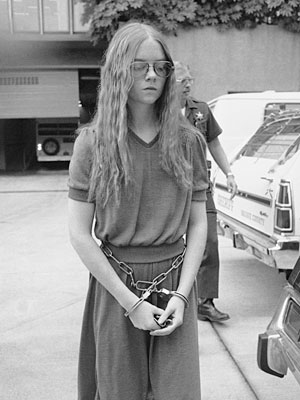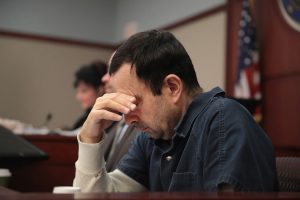“Ugh, it’s Monday” are the words that usually follow the arrival of the most dreaded day of the week. The sighs floating in the air are palpable and nothing seems possible. Mondays always carry with them a negative connotation and contain components such as depression, fatigue, and anguish. But to a San Diego elementary school, and to a troubled sixteen year old, Monday, January 29, 1979 held an even more distressing meaning.

Students at Grover Cleveland Elementary School, located in San Diego, California, began what they believed would be a normal Monday morning like any other, with bells ringing and students racing to their classes. Little did they know, however, that across the street, sixteen-year-old Brenda Ann Spencer was aiming her .22 caliber semiautomatic rifle right at society’s ultimate refuge, the elementary school, and its surroundings. After the first bell rang, Brenda broke the panels on the front door of her home, which was located right across the street from the elementary school. And she began to fire. The school’s principal, Burton Wragg, while rushing outside, was hit on the shoulder and chest with Spencer’s bullets and eventually died. Michael Suchar, the school’s custodian, ran outside with a blanket in order to cover Wragg and keep him from going into shock, but he quickly became the second victim of Spencer’s shooting and lost his life. In between all the chaos, 28 year old Robert Robb, a recent graduate of the police academy, while examining Wragg’s and Suchar’s bodies, was shot under his right shoulder blade.1 He would go on to survive though, along with the eight other children who were wounded in the incident. At least three of those children had abdominal wounds. A nine-year-old student, Cam Miller, was struck in the back with a bullet that exited through his chest without hitting any internal organs. Another, Christy Buell, was shot through her abdomen and in the buttocks, and had to undergo surgery in order to repair her intestine.2
When Gus Stevens, a reporter for the San Diego Evening Tribune, began calling around the area to gain more information about the shooting, he coincidentally placed a call to Spencer’s home where she gave him exactly what he wanted. She described the shooter, a sixteen year old, and the shooter’s address. When Stevens realized that she gave him her own address, he recognized what was going on and requested an interview while another staff member informed the police of the situation. The police, now aware of where the shots were coming from, were able evacuate the children and obstruct Spencer’s line of sight while trying to negotiate with her. After several hours, Brenda Spencer surrendered her weapon and several rounds of ammunition, and was subsequently arrested. While on the phone with Stevens, Spencer had stated that she was just shooting for the “fun of it.” She went on to say that she just didn’t like Mondays and did this “because it’s a way to cheer up the day.”3

Contrary to her initial claim, she later went on to state in her 2001 parole hearing that she had been “sexually abused by [her] father” and was “waiting for the cops to show up so they could shoot [her].”4 This new information has fueled many more theories today about Brenda Spencer’s true motives in committing such a crime. During her pretrial psychological testing, an injury to Spencer’s temporal lobe came to light. Spencer has also stated in a letter from prison that she experiences “grand mal seizures” that she has to counteract with medications.5 Such a brain injury would definitely be a precursor to epilepsy, which is two to four times more common among violent offenders than the public.6 The lack of treatment she received for this disease, to some, proves the neglect that she experienced from her family and in her childhood. Psychologist Jonathan Fast introduces the idea that her brain injury, abuse, and the effects of it pushed her to her final actions. He believes that the shame, ridicule, inferiority, and powerlessness that she felt encouraged her to go as far as she did. In another letter she wrote in prison, she stated that her “father had done everything a person could do to another person. The beatings, the touching, the emotional abuse.” She went on to state that no one, not teachers or counselors, gave her assistance through this, so she simply thought that this was how the world and how life worked. When her father gifted her the .22 caliber rifle, she thought that he was finally telling her to do it: to take her life successfully, unlike her past suicide attempts, and leave the world forever.7
Whether these theories are true or not, Brenda Spencer was tried as an adult and pleaded guilty to two counts of murder and nine counts of assault. She was sentenced to twenty-five years to life in prison, and is still serving her sentence at the California Institute for Women. The shooting has inspired a song by the Boomtown Rats called “I Don’t Like Mondays,” and has also gained other media coverage through a documentary.8 Her action went down in history as the first high profile school shooting and has become a vanguard to many future, unimaginable school situations and violent outbreaks. Whether Spencer was a cold-hearted killer or a truly lost and confused soul that simply wanted an escape, it is undeniable that her horrible actions have had some frightening consequences in our modern world.
- Jonathan Fast, Ceremonial Violence (New York: The Overlook Press, 2008), 25, 70-71. ↵
- Tamara Jones, “Look Back in Sorrow,” Good Housekeeping 227, no.5 (November 1998): 118. ↵
- Jonathan Fast, “Unforgiven and Alone: Brenda Spencer and Secret Shame,” in School Shootings: International Research, Case Studies, And Concepts For Prevention, ed. Nils Böckler (New York: Springer, 2013), 253-255. ↵
- Debra Sevey, “Subsequent Parole Consideration Hearing of Brenda Spencer,” (Capitol Electronic Reporting, 2001), 15-16. ↵
- Jennifer Furio, Letters From Prison: Voices Of Women Murderers (New York: Algora Pub., 2001), 134. ↵
- Jonathan Fast, ” Unforgiven and Alone: Brenda Spencer and Secret Shame,” in School Shootings: International Research, Case Studies, And Concepts For Prevention, ed. Nils Böckler (New York: Springer, 2013), 251. ↵
- Jennifer Furio, Letters From Prison: Voices Of Women Murderers (New York: Algora Pub., 2001), 134-135. ↵
- Encyclopedia of School Crime and Violence, September 2011, s.v. “Brenda Spencer,” by Laura L. Finley. ↵



243 comments
Josemaria Soriano
This article has really been very interesting for me, much more because of the context of Las Vegas Mass Shooting this week. There is something that, as a foreigner, has always intrigued me: Why does the United States present so many cases of mass shootings? I come from Peru, and in my country there is, as in every Latin American country, a lot of crime, kidnappings, hijackings, drug trafficking, etc … But never in the history of my country have there been shootings like this one, neither in other Latin country. The United States presents 33% of all mass shootings in the world. Undoubtedly this is something that should be reviewed, studied and solved. What causes Americans to attack their own fellow citizens? Is the easy availability of fire weapons in this country a cause? Or is there a promoting violence factor in American culture? There are many questions and few answers. One thing that is certain is that the United States must urgently implement dementia identification policies to prevent tragedies, such as the Cleveland Elementary School Shooting, happen.
Clarissa Bustamante
The title of the article was very well thought out; it really caught my attention because I wanted to know more about what you meant by “The Case of the Mondays”. It was a very put together article because it gives such descriptive and horrific insight to the incident of an evil young woman and everything she took part in. It is sad to think that some children were evil because they’re suppose to be seen as innocent and uplifting.
Amanda Perez
Aside from being beautifully written, this article truly brings to light how important it is to monitor mental health and be aware of warning signs that people give when they are being hurt or abused at home. Rather than this being a model for future school killings, it should have been a lesson for school staffs to take the initiative of helping students in need.
Lisa Varela
What a terrifying story! I had never heard of this school shooting before this news article. I had no idea that the first school shooting occurred in the 70s. Nowadays a school shooting is not something new to us, as sad as that is. That doesn’t make it any less tragic nor frightening. Brenda Spencer was so young when she committed this crime, a mere 16 years old! I can never comprehend how anyone could do such harm to their fellow human beings. Great news article!
Marco Picardo
The article was very informative as well as disturbing in terms of the nature in which the shooter acted. To target such a soft spot is troubling to even think about. Think about it, she targeted an Elementary school. These children were literally “babies” in the world. If it’s one thing I can’t stand, it’s people harming children. I could only wonder what these young children went through. Before reading this article I had no idea such an event had taken place.
Alejandra Mendez
Although I had some brief knowledge about the Grover Cleveland Elementary shooting, I did not know much about it nor who the shooter was. It’s sad to think that someone so young as Spencer was can be abused so much to push her into doing something so wrong, if what she says about her abuse is true. What is even more sad is that there are probably many more people like her that go through what she went through every day as well. This article was overall very informative and I definitely learned something new from it.
Benjamin Voy
What a totally awful event in which innocent civillians and even children were targeted. I truly don’t understand what must make a person so evil to do such a thing and then to justify their actions by saying “I just don’t like Mondays”. The victims and families of the victims will be scarred for ever and will always remember this truly horrific day. Great article
Maria Callejas
First and foremost, AWESOME introduction, I was instantly hooked. Thanks to your great use of evidence, that day was clearly illustrated to the tee. This is indeed a surreal event, how could a kid just kill people “because it’s a way to cheer up the day”. However, it is obvious that she committed such act because of the damage temporal lobe, because no one in their sane mind would kill just because of it. Overall, great job!
Alise Balderas
I got the chills reading this. Sadly, events like these seem to be common nowadays. Look at what just happened in Las Vegas. Things like this happen far too often. It is sad that in today’s world it is necessary for schools and other public places to be equipped with plans in case of emergencies such as shootings, attacks, etc. because they are so common. Before I read this, I had never heard of this shooting. I always thought events like these were a more recent matter, so it is crazy for me to see that the way the world is now has been building up for decades now. Summing things up, I found this article tragic, yet very interesting. It taught me something new.
Joel Gracia
This was a very informative and disturbing story. I refuse to believe that anyone of normal mental health would ever do something such as this and be remorseless about it. If Brenda Spencer’s mental condition was indeed gained over time by domestic abuse from her mother, the even bigger tragedy is that a parent would damage a youth this much.